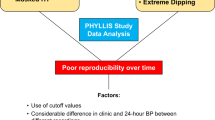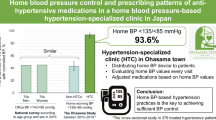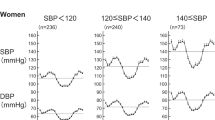Abstract
Home blood pressure has a higher predictive power for cardiovascular events than office blood pressure, and there is a particularly close association between morning blood pressure at home and the incidence of cardiovascular events and mortality in the early morning. In this study, we evaluated the efficacy of a long-acting N-type and L-type calcium channel blocker, cilnidipine, in reducing morning blood pressure at home and in ameliorating the white-coat effect. Fifty-eight subjects diagnosed with both essential hypertension and morning hypertension (43 currently being treated, 15 new patients) were prescribed cilnidipine at a dosage of 10–20 mg per day for 8 weeks. After the addition of or a change to cilnidipine, the morning systolic blood pressure (SBP) was controlled to less than 135 mmHg in 25 (58%) out of the 43 patients currently receiving antihypertensive medication. The office SBP in 24 out of those 25 patients was also maintained under 140 mmHg. In the 15 newly treated patients, the morning SBP of 12 patients (80%) was controlled to less than 135 mmHg after administration of cilnidipine. At baseline, 17 patients showed a clear white-coat effect, in which the difference between office blood pressure and home blood pressure was 20/10 mmHg or more. The white-coat effect was depressed significantly after cilnidipine administration. These results suggest that cilnidipine may serve as a useful antihypertensive medication in the treatment of morning hypertension, and also attenuate the white-coat effect in patients with essential hypertension.
Similar content being viewed by others
Article PDF
References
Staessen JA, Wang JG, Thijs L : Cardiovascular prevention and blood pressure reduction: a quantitative overview updated until 1 March 2003. J Hypertens 2003; 21: 1055–1076.
Ohkubo T, Imai Y, Tsuji I, et al: Home blood pressure measurement has a stronger predictive power for mortality than does screening blood pressure measurement: a population-based observation in Ohasama, Japan. J Hypertens 1998; 16: 971–975.
Bobrie G, Chatellier G, Genes N, et al: Cardiovascular prognosis of “masked hypertension” detected by blood pressure self-management in elderly treated hypertensive patients. JAMA 2004; 291: 1342–1349.
White WB : Cardiovascular risk and therapeutic intervention for the early morning surge in blood pressure and heart rate. Blood Press Monit 2001; 6: 63–72.
Imai Y, Otsuka K, Kawano Y, et al: Japanese Society of Hypertension (JSH) guidelines for self-monitoring of blood pressure at home. Hypertens Res 2003; 26: 771–782.
Tominaga M, Ohya Y, Tsukashima A, et al: Ambulatory blood pressure monitoring in patients with essential hypertension treated with a new calcium antagonist, cilnidipine. Cardiovasc Drugs Ther 1997; 11: 43–48.
Kitahara Y, Saito F, Akao M, et al: Effect of morning and bedtime dosing with cilnidipine on blood pressure, heart rate, and sympathetic nervous activity in essential hypertensive patients. J Cardiovasc Pharmacol 2004; 43: 68–73.
Ohkubo T, Obara T, Funahashi J, et al: Control of blood pressure as measured at home and office, and comparison with physicians' assessment of control among treated hypertensive patients in Japan: first report of the Japan Home versus Office Blood Pressure Measurement Evaluation (J-HOME) study. Hypertens Res 2004; 27: 755–763.
Obara T, Ohkubo T, Funahashi J, et al: Isolated uncontrolled hypertension at home and in the office among treated hypertensive patients from the J-HOME study. J Hypertens 2005; 23: 1653–1660.
White WB : Relevance of blood pressure variation in the circadian onset of cardiovascular events. J Hypertens 2003; 21: S9–S15.
Kumagai Y : Strategies against high blood pressure in the early morning. Clin Exp Hypertens 2004; 26: 107–118.
Uchida H, Nakamura Y, Kaihara M, et al: Practical efficacy of telmisartan for decreasing home blood pressure and pulse wave velocity in patients with mild-to-moderate hypertension. Hypertens Res 2004; 27: 545–550.
Yoshimoto R, Dohmoto H, Yamada K, Goto A : Prolonged inhibition of vascular contraction and calcium influx by the novel 1,4-dihydropyridine calcium antagonist cilnidipine (FRC-8653). Jpn J Pharmacol 1991; 56: 225–229.
Hosono M, Iida H, Ikeda K, et al: In vitro and ex vivo Ca-antagonistic effect of 2-methoxyethyl(E)-3-phenyl-2-propen-1-yl(±)-1,4-dihydro-2,6-dimethyl-4-(3-nitrophenyl)pyridine-3,5-dicarboxylate (FRC-8653), a new dihydropyridine derivative. J Pharmacobiodyn 1992; 15: 547–553.
Nakajima M, Yamada S, Uchida S, Kimura R : In vitro measurement of 1,4-dihydropyridine receptors in mesenteric arteries of spontaneously hypertensive rats and effect of nifedipine and cilnidipine. Biol Pharm Bull 2002; 25: 24–28.
Weber MA : The 24-hour blood pressure pattern: does it have implications for morbidity and mortality? Am J Cardiol 2002; 89: 27A–33A.
Kario K, Pickering TG, Umeda Y, et al: Morning surge in blood pressure as a predictor of silent and clinical cerebrovascular disease in elderly hypertensives: a prospective study. Circulation 2003; 107: 1401–1406.
Kamoi K, Ikarashi T : The bedtime administration of doxazosin controls morning hypertension and albuminuria in patients with type-2 diabetes: evaluation using home-based blood pressure measurements. Clin Exp Hypertens 2005; 27: 369–376.
Chrysant SG, Chrysant GS, Desai A : Current status of angiotensin receptor blockers for the treatment of cardiovascular diseases: focus on telmisartan. J Hum Hypertens 2005; 19: 173–183.
Ide H, Tsutsumi T, Takeyama Y, Osada H : Actions of calcium antagonists on circadian systolic blood pressure rhythm and autonomic function in hypertensive patients. Jpn J Clin Pharmacol Ther 2004; 35: 1–8.
Kario K, James GD, Marion R, Ahmed M, Pickering TG : The influence of work- and home-related stress on the levels and diurnal variation of ambulatory blood pressure and neurohumoral factors in employed women. Hypertens Res 2002; 25: 499–506.
Pickering TG, Coats A, Mallion JM, Mancia G, Verdecchia P : Task force V: white-coat hypertension. Blood Press Monit 1999; 4: 333–341.
Kumpusalo E, Teho A, Laitila R, Takala J : Janus faces of the white coat effect: blood pressure not only rises, it may also fall. J Hum Hypertens 2002; 16: 725–728.
Mulè G, Nardi E, Cottone S, et al: Relationships between ambulatory white coat effect and left ventricular mass in arterial hypertension. Am J Hypertens 2003; 16: 498–501.
Munakata M, Saito Y, Nunokawa T, Ito N, Fukudo S, Yoshinaga K : Clinical significance of blood pressure response triggered by a doctor's visit in patients with essential hypertension. Hypertens Res 2002; 25: 343–349.
Strandberg TE, Salomaa V : White coat effect, blood pressure and mortality in men: prospective cohort study. Eur Heart J 2000; 21: 1714–1718.
Sakaki T, Naruse H, Masai M, et al: Cilnidipine as an agent to lower blood pressure without sympathetic nervous activation as demonstrated by iodine-123 metaiodobenzylguanidine imaging in rat hearts. Ann Nucl Med 2003; 17: 321–326.
Sakata K, Yoshida H, Obayashi K, et al: Comparative effect of cilnidipine and quinapril on left ventricular mass in mild essential hypertension. Drugs Exp Clin Res 2003; 29: 117–123.
Nagai H, Minatoguchi S, Chen XH, et al: Cilnidipine, an N+L-type dihydropyridine Ca channel blocker, suppresses the occurrence of ischemia/reperfusion arrhythmia in a rabbit model of myocardial infarction. Hypertens Res 2005; 28: 361–368.
Author information
Authors and Affiliations
Corresponding author
Rights and permissions
About this article
Cite this article
Yamagishi, T. Beneficial Effect of Cilnidipine on Morning Hypertension and White-Coat Effect in Patients with Essential Hypertension. Hypertens Res 29, 339–344 (2006). https://doi.org/10.1291/hypres.29.339
Received:
Accepted:
Issue date:
DOI: https://doi.org/10.1291/hypres.29.339
Keywords
This article is cited by
-
Effectiveness and Effect on Renal Parameters of Amlodipine vs. Other Dihydropyridine Calcium Channel Blockers in Patients with Essential Hypertension: Retrospective Observational Study Based on Real-World Evidence from Electronic Medical Records
Cardiology and Therapy (2021)
-
L/N-type calcium channel blocker cilnidipine reduces plasma aldosterone, albuminuria, and urinary liver-type fatty acid binding protein in patients with chronic kidney disease
Heart and Vessels (2013)
-
Factors Influencing White-coat Effect
American Journal of Hypertension (2008)



